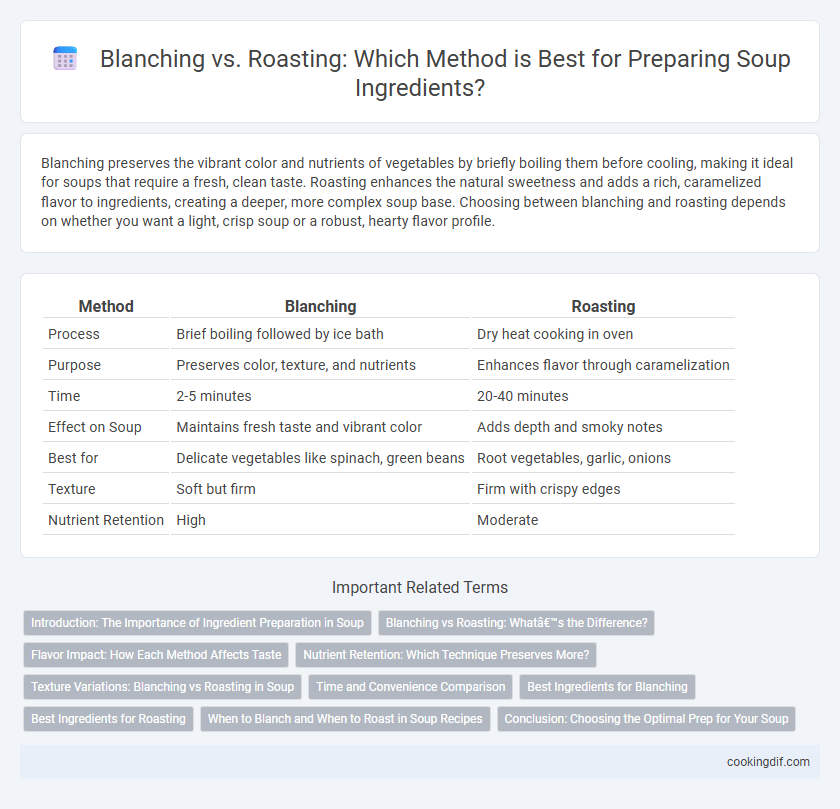Blanching preserves the vibrant color and nutrients of vegetables by briefly boiling them before cooling, making it ideal for soups that require a fresh, clean taste. Roasting enhances the natural sweetness and adds a rich, caramelized flavor to ingredients, creating a deeper, more complex soup base. Choosing between blanching and roasting depends on whether you want a light, crisp soup or a robust, hearty flavor profile.
Table of Comparison
| Method | Blanching | Roasting |
|---|---|---|
| Process | Brief boiling followed by ice bath | Dry heat cooking in oven |
| Purpose | Preserves color, texture, and nutrients | Enhances flavor through caramelization |
| Time | 2-5 minutes | 20-40 minutes |
| Effect on Soup | Maintains fresh taste and vibrant color | Adds depth and smoky notes |
| Best for | Delicate vegetables like spinach, green beans | Root vegetables, garlic, onions |
| Texture | Soft but firm | Firm with crispy edges |
| Nutrient Retention | High | Moderate |
Introduction: The Importance of Ingredient Preparation in Soup
Blanching preserves the vibrant color and texture of vegetables by briefly boiling and then shocking them in ice water, which helps maintain nutrients and reduces cooking time in soup preparation. Roasting enhances flavor depth through caramelization and Maillard reactions, adding a rich, complex taste to soups with a slightly smoky undertone. Choosing the appropriate method depends on the desired soup profile, with blanching favoring freshness and roasting focusing on intensified, robust flavors.
Blanching vs Roasting: What’s the Difference?
Blanching involves briefly boiling vegetables to preserve color, texture, and nutrients, making it ideal for soup ingredients that require softening without losing freshness. Roasting uses dry heat to caramelize sugars and enhance flavors, adding depth and a smoky profile to soups. Choosing blanching or roasting depends on whether the soup benefits from mild, crisp vegetables or rich, concentrated flavors.
Flavor Impact: How Each Method Affects Taste
Blanching preserves the natural, fresh flavor of vegetables by briefly boiling them, resulting in a mild taste that enhances the overall soup profile without overpowering other ingredients. Roasting intensifies flavor through caramelization and Maillard reactions, creating deeper, richer, and slightly sweet notes that add complexity and warmth to the soup. Each method distinctly influences taste, with blanching maintaining subtlety and roasting delivering bold, robust flavors.
Nutrient Retention: Which Technique Preserves More?
Blanching preserves nutrients in soup ingredients by briefly boiling vegetables, minimizing vitamin loss and maintaining antioxidant levels more effectively than roasting. Roasting involves higher temperatures for longer periods, which can degrade heat-sensitive nutrients such as vitamin C and certain B vitamins. Therefore, blanching is generally preferred for maximizing nutrient retention before adding ingredients to soup.
Texture Variations: Blanching vs Roasting in Soup
Blanching vegetables for soup preserves a crisp-tender texture by quickly cooking them in boiling water, which helps retain their natural color and firmness. Roasting, on the other hand, caramelizes the ingredients, creating a deeper, more complex flavor profile and a softer, sometimes slightly charred texture that enhances the soup's richness. Choosing between blanching and roasting depends on the desired texture contrast and flavor depth in the final soup.
Time and Convenience Comparison
Blanching vegetables for soup typically takes 2 to 5 minutes, quickly softening ingredients while preserving color and nutrients, making it ideal for fast preparation. Roasting requires 20 to 40 minutes, enhancing flavor through caramelization but demanding more time and monitoring. For convenience, blanching suits quick recipes, whereas roasting suits richer, deeper-flavored soups needing longer cooking times.
Best Ingredients for Blanching
Blanching is ideal for preserving the vibrant color, texture, and nutritional value of fresh vegetables like green beans, spinach, and broccoli when preparing soup ingredients. This quick boiling method halts enzyme activity, making these vegetables crisp and bright while softening them slightly for easy incorporation into soups. Root vegetables and tougher greens benefit less from blanching, as roasting better enhances their flavors through caramelization.
Best Ingredients for Roasting
Root vegetables such as carrots, parsnips, and beets are ideal for roasting due to their natural sweetness that intensifies under dry heat. Roasting enhances the flavor complexity of garlic and onions, creating a rich, caramelized base for soups. Choosing dense vegetables like squash and bell peppers ensures they maintain texture while developing deep, savory notes when roasted.
When to Blanch and When to Roast in Soup Recipes
Blanching vegetables before adding them to soup preserves their vibrant color and crisp texture, making it ideal for ingredients like green beans, broccoli, and peas that benefit from a quick cook. Roasting is preferred for root vegetables and aromatic ingredients such as carrots, onions, and garlic, as it enhances their natural sweetness and deepens flavor profiles. Choosing blanching or roasting depends on the desired texture and taste intensity, with blanching suited for fresh, bright elements and roasting for richer, caramelized notes in soups.
Conclusion: Choosing the Optimal Prep for Your Soup
Blanching preserves the vibrant color and crisp texture of vegetables, making it ideal for clear, light soups that highlight fresh ingredients. Roasting enhances depth and caramelization, bringing a rich, smoky flavor suited for hearty, robust soups. Selecting the optimal prep method depends on the desired flavor profile and texture, balancing freshness with complexity to elevate your soup.
Blanching vs Roasting for preparing ingredients Infographic

 cookingdif.com
cookingdif.com